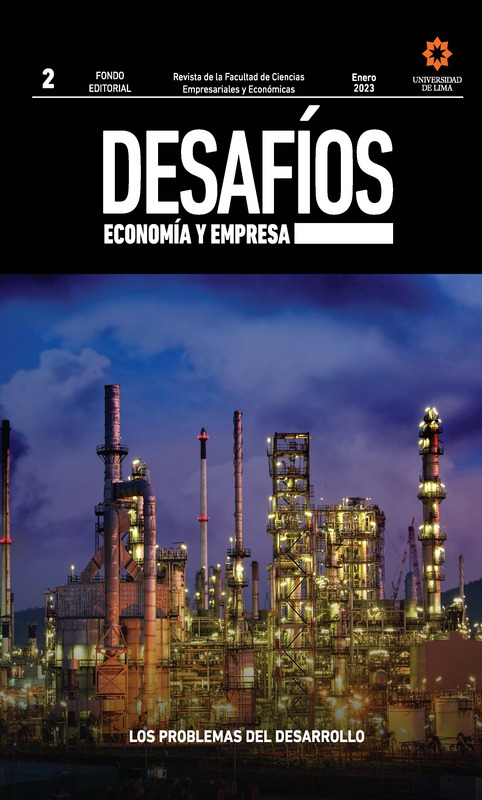El impacto del consumo de energía, el desarrollo del sistema financiero y el ingreso sobre las emisiones de CO2 en el Perú
DOI:
https://doi.org/10.26439/ddee2022.n002.5720Palabras clave:
degradación ambiental, consumo de energía, sistema financiero, Curva Ambiental de KuznetsResumen
Este estudio realizó un análisis del impacto del consumo de energía, el desarrollo del sistema financiero y el ingreso per cápita sobre las emisiones de CO2 por medio de un modelo de regresión y de un Vector de Corrección de Errores para el caso peruano. Se halló que existe una relación positiva entre el consumo de energía y las emisiones de CO2 y que el desarrollo financiero no tiene impacto sobre la calidad ambiental. A su vez, no se encontró evidencia a favor de la Curva Ambiental de Kuznets en el caso peruano. De este modo, aunque el Perú ha logrado altas tasas de crecimiento, el consumo de fuentes de energía alternativas y amigables con el medioambiente debe tener mayor participación en la matriz energética.
Descargas
Referencias
Akbostancı, E., Türüt-Aşık, S., & Tunç, G. İ. (2009). The relationship between income and environment in Turkey: is there an environmental Kuznets Curve? Energy Policy, 37(3), 861-867. https://doi.org/10.1016/j.enpol.2008.09.088
Apergis, N., & Ozturk, I. (2015). Testing environmental Kuznets Curve hypothesis in Asian countries. Ecological Indicators, 52, 16-22. https://doi.org/10.1016/j.ecolind.2014.11.026
Arnold, J. E. M., Kohlin, G., & Persson, R. (2006). Woodfuels, livelihoods and policy interventions: changing perspectives. World Development, 34(3), 596-611. https://doi.org/10.1016/j.worlddev.2005.08.008
Bertinelli, L., & Strobl, E. (2005). The environmental Kuznets Curve semi-parametrically revisited. Economics Letters, 88(3), 350-357. https://doi.org/10.1016/j.econlet.2005.03.004
Fan, L. W., Pan, S. J., Liu, G. Q., & Zhou, P. (2017). Does energy efficiency affect financial performance? Evidence from Chinese energy-intensive firms. Journal of Cleaner Production, 151, 53-59. https://doi.org/10.1016/j.jclepro.2017.03.044
Frankel, J., & Romer, D. (1999). Does trade cause growth? American Economic Review, 89(3), 379-399. https://doi.org/10.1257/aer.89.3.379
Grossman, G., & Krueger, A. (1995). Economic growth and the environment. The Quarterly Journal of Economics, 110(2), 353-377. https://doi.org/10.2307/2118443
Gudynas, E. (2010). Desarrollo sostenible: una guía básica de conceptos y tendencias hacia otra economía. Otra Economía, 4(6), 43-66. https://www.revistaotraeconomia.org/index.php/otraeconomia/article/view/1182
Jalil, A., & Feridun, M. (2011). The impact of financial development on the environment in China: a cointegration analysis. Energy Economics, 33(2), 284-291. https://doi.org/10.1016/j.eneco.2010.10.003
Kizilkaya, O. (2017). The impact of economic growth and foreign direct investment on CO2 emissions: the case of Turkey. Turkish Economic Review, 4(1), 106-118. http://kspjournals.org/index.php/TER/article/view/1173
Levinson, A., & Scott Taylor, M. (2008). Unmasking the pollution haven effect. International EconomicReview, 49(1), 223-254. https://doi.org/10.1111/j.1468-2354.2008.00478.x
Ma, X., Ahmad, N., & Oei, P. Y. (2021). Environmental Kuznets Curve in France and Germany: role of renewable and nonrenewable energy. Renewable Energy, 172, 88-99. https://doi.org/10.1016/j.renene.2021.03.014
Matos-Ortega, M., & Izaguirre-López, G. (10 de noviembre del 2020). Incentivos fiscales verdes para fomentar el uso de energías renovables en la minería peruana. Derecho Ambiental. https://prometheo.pe/incentivos-fiscales-verdes-para-fomentarel-uso-de-energias-renovables-en-la-mineria-peruana/
Naciones Unidas (s. f.). Objetivos de desarrollo sostenible. http://www.un.org/sustainabledevelopment/es/objetivos-de-desarrollo-sostenible/
Nicholson, W. (2009). Intermediate microeconomics and its applications (11.ª ed.). South-Western Collage Publishing.
Ortiz-Paniagua, C. F., & Gómez, M. (2021). Crecimiento económico y calidad ambiental en América Latina, perspectiva desde Kuznets, 1970-2016. Nueva Época, 29(55), 17-36. https://doi.org/10.24275/etypuam/ne/552021/ortiz
Ozturk, I., & Acaravci, A. (2010). CO2 emissions, energy consumption and economic growth in Turkey. Renewable and Sustainable Energy Reviews, 14(9), 3220-3225. https://doi.org/10.1016/j.rser.2010.07.005
Páez, G. (10 de mayo del 2021). Curva Ambiental de Kuznets. https://economipedia.com/definiciones/curva-ambiental-de-kuznets.html
Pettinger, T. (11 de septiembre del 2019). Environmental Kuznets curve. https://www.economicshelp.org/blog/14337/environment/environmental-kuznets-curve/
Pontarollo, N., & Muñoz, R. M. (2020). Land consumption and income in Ecuador: a case of an inverted environmental Kuznets Curve. Ecological Indicators, 108, 105699. https://doi.org/10.1016/j.ecolind.2019.105699
Sadorsky, P. (2010). The impact of financial development on energy consumption in emerging economies. Energy Policy, 38(5), 2528-2535. https://doi.org/10.1016/j.enpol.2009.12.048
Salcedo, N. (2014). Generación de energía limpia. Conferencia en el marco de la III Charla Verde realizada en la Universidad de Lima (Perú).
Shahbaz, M., Khraief, N., Uddin, G. S., & Ozturk, I. (2014). Environmental Kuznets Curve in an open economy: a bounds testing and causality analysis for Tunisia. Renewable and Sustainable Energy Reviews, 34, 325-336. https://doi.org/10.1016/j.rser.2014.03.022
Soytas, U., & Sari, R. (2003). Energy consumption and GDP: Causality relationship in G7 countries and emerging markets. Energy Economics, 25(1), 33-37. https://doi.org/10.1016/S0140-9883(02)00009-9
Stern, N. (2006). The economics of climate change: the Stern review. https://doi.org/10.1017/CBO9780511817434
Suri, V., & Chapman, D. (1998). Economic growth, trade and energy: implications for the Environmental Kuznets Curve. Ecological Economics, 25(2), 195-208. http://dx.doi.org/10.1016/S0921-8009(97)00180-8
Van der Kroon, B., Brouwer, R., & Van Beukering, P. J. H. (2013). The energy ladder: theoretical myth or empirical truth? Results from a meta-analysis. Renewable and Sustainable Energy Reviews, 20, 504-513. https://doi.org/10.1016/j.rser.2012.11.045
Zhang, X., & Cheng, X. (2009) Energy consumption, carbon emissions, and economic growth in China. Ecological Economics, 68(10), 2706–2712. https://doi.org/10.1016/j.ecolecon.2009.05.011


